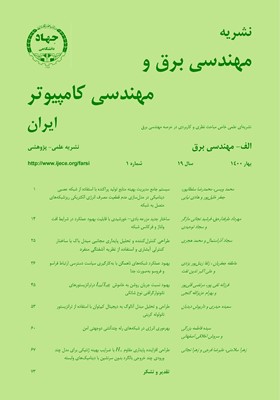بهبود عملکرد شبکه های ناهمگن با به کارگیری سیاست دسترسی ارتباط فراسو و فروسو به صورت جدا
محورهای موضوعی : مهندسی برق و کامپیوترعاطفه جعفریان 1 , زلفا زینل پوریزدی 2 , علی اکبر تدین تفت 3
1 - دانشگاه یزد
2 - دانشگاه یزد
3 - دانشگاه یزد
کلید واژه: ارتباط فراسوتعادل بارسیاست دسترسی ارتباط فراسو و فروسو به صورت جداشبکههای ناهمگنمحدودیت بکهال,
چکیده مقاله :
یکی از چالشهای اساسی شبکههای سلولی ناهمگن که در آنها ایستگاههای پایه مختلف با ویژگیهای متفاوت به سرویسدهی کاربران میپردازند، سیاست دسترسی کاربران به ایستگاههای پایه است. در این مقاله به منظور بهبود عملکرد ارتباط فراسو در شبکه ناهمگنی که از محدودیت بکهال در ایستگاههای پایه رنج میبرد، سیاست دسترسی ارتباط فراسو و فروسو به صورت جدا پیشنهاد میگردد. در این نوع سیاست، کاربر میتواند به دو ایستگاه پایه مجزا در ارتباط فراسو و فروسو متصل گردد. به منظور بهرهبرداری کارامد از منابع شبکه و افزایش گذردهی کاربران متصل به سلولهای پربار، معیار دسترسی کاربران به ایستگاههای پایه در ارتباط فراسو، برقراری تعادل بار در این ارتباط در نظر گرفته شده است. به این منظور شاخص ارتباط کاربران به ایستگاههای پایه و توان ارسالی آنها از حل مسأله بهینهسازی بیشینهکردن مجموع نرخ مؤثر کاربران به دست میآید. نتایج شبیهسازی نشان میدهد که با به کارگیری این معیار، در سیاست دسترسی ارتباط فراسو و فروسو به صورت جدا، شاخص تعادل بار، کارایی انرژی و متوسط نرخ مؤثر کاربران در این ارتباط به طور قابل توجهی بهبود مییابد. از آنجا که نرمافزار گمز جواب دقیق مسأله بهینهسازی را محاسبه میکند و به منظور ارزیابی کارایی الگوریتم پیشنهادی، مسأله فوق در شبکه بکهال با استفاده از نرمافزار گمز نیز حل شده است. نتایجی که از الگوریتم پیشنهادی به دست آمده به نتایج محاسبهشده از نرمافزار گمز نزدیک میباشد که نشاندهنده دقت مناسب الگوریتم پیشنهادی است. در ادامه نیز روشی برای بهبود تعادل بار در ارتباط فراسو در شبکههای ناهمگن که دارای محدودیت بکهال میباشند، پیشنهاد میشود و کارایی آن مورد ارزیابی قرار میگیرد.
One of the major challenges in the heterogeneous networks, where different base stations with different capabilities serve users, is the access policy for establishing a communication link between the user and its serving node. To overcome this challenge in a heterogeneous network which also suffers from the backhaul constraint, a special kind of “decoupled uplink and downlink access” policy is proposed in this paper, which let users to be served by different base stations in uplink and downlink communications. More precisely, in order to efficiently utilize the system resources, increase the users’ throughput, and guarantee the users’ fairness, a special load balancing association policy is considered in the uplink transmission and a problem which maximizes the weighted sum of users’ effective rates is solved. Simulation results show that using this association policy for the considered scenario, significantly improves the load balancing index, energy efficiency, and also users’ effective rate compared to the scenario which considers the criterion of the maximum received power of the downlink connection for both uplink and downlink transmissions. In addition we propose an algorithm which further improves the load balancing considering the backhaul constraint of the base stations and evaluate its efficiency.
[1] A. Ghosh, N. Mangalvedhe, and R. Ratasuk, "Heterogeneous cellular networks: from theory to practice," IEEE Commun. Mag., vol. 50, no. 6, pp. 54-64, Jun. 2012.
[2] Z. Sattar, J. V. C. Evangelista, G. Kaddoum, and N. Batani, "Spectral efficiency analysis of the decoupled access for downlink and uplink in two-tier network," IEEE Trans. Veh. Technol., vol. 68, no. 5, pp. 4871-4883, May 2019.
[3] S. Singh, X. Zhang, and J. G. Andrews, "Joint rate and SINR coverage analysis for decoupled uplink-downlink biased cell associations in HetNets," IEEE Trans. Wireless Commun., vol. 14, no. 10, pp. 5360-5373, May 2015.
[4] F. Boccardi, J. Andrews, H. Elshaer, M. Dohler, S. Parkvall, and P. Popovski, "Why to decouple the uplink and downlink in cellular networks and how to do it?" IEEE Wireless Commun. Mag., vol. 54, no. 3, pp. 110-117, Mar. 2016.
[5] L. Zhang, W. Nie, G. Feng, F. Zheng, and S. Qin, "Uplink performance improvement by decoupling uplink/downlink access in HetNets," IEEE Trans. Veh. Technol., vol. 66, no. 8, pp. 6862-6876, Aug. 2017.
[6] R. Li, K. Luo, T. Jiang, and S. Jin, "Uplink spectral efficiency analysis of decoupled access in multiuser MIMO HetNets," IEEE Trans. Veh. Technol., vol. 67, no. 5, pp. 4289-4302, Jan. 2018.
[7] R. Li, X. Liu, K. Luo, T. Jiang, and S. Jin, "Decoupled access in HetNets with backhaul constrained small base stations," IEEE Access, vol. 6, pp. 27028-27038, Jun. 2018.
[8] G. Ghatak, A. De Domenico, and M. Coupechoux, "Coverage analysis and load balancing in HetNets with millimeter wave multi-RAT small cells," IEEE Trans. Wireless Commun., vol. 17, no. 5, pp. 3154-3169, May 2018.
[9] D. Liu, Y. Chen, T. Zhang, K. Chai, J. Loo, and A. Vinel, "Stackelberg game based cooperative user relay assisted load balancing in cellular networks," IEEE Commun. Letters, vol. 17, no. 2, pp. 424-427, Feb. 2013.
[10] T. Zhou, Z. Liu, J. Zhao, C. Li, and L. Yang, "Joint user association and power control for load balancing in downlink heterogeneous cellular networks," IEEE Trans. Veh. Technol., vol. 67, no. 3, pp. 2582-2593, Mar. 2018.
[11] S. Low and D. Lapsley, "Optimization flow control-I: basic algorithm and convergence," IEEE/ACM Trans. Netw., vol. 7, no. 6, pp. 861-874, Dec. 1999.
[12] M. Chiang, C. W. Tan, D. P. Palomar, D. O'neill, and D. Julian, "Power control by geometric programming," IEEE Trans. Wireless Commun., vol. 6, no. 7, pp. 2640-2651, Jul. 2007.
[13] M. Chiang, "Balancing transport and physical layers in wireless multihop networks: jointly optimal congestion control and power control," IEEE J. Sel. Areas Commun., vol. 23, no. 1, pp. 104-116, Jan. 2005.
[14] J. Nocedal and S. Wright, Numerical Optimization, New York, NY, USA: Springer, 1999.
[15] وبسایت تخصصی نرم¬افزار گمز، http://gamsbook.ir.


